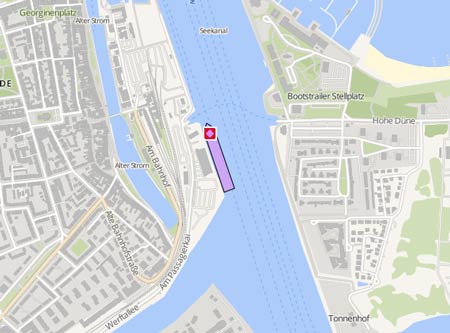LAMBOUSA 2
Course/Position
Latest ports
Latest Waypoints
Latest news
Marine life reappears at Larnaca’s protected seabed due to artificial reefs
Five years after the sinking of the first two vessels in Larnaca’s Marine Protected Area (MPA), significant improvements have been observed in the previously barren seabed near Oroklini, which is now showing signs of regeneration. The addition of the 'Lambousa II' last month by the Department of Fisheries has further enhanced these conservation efforts while simultaneously increasing the area’s appeal to diving enthusiasts. The protected zone, which includes three sunken vessels and amphoras deployed by the Larnaca Tourism Development and Promotion Company, now spans an area of 2.2 square kilometres. What distinguishes this site from Cyprus’s five other artificial reefs is that it houses the largest sunken vessel, the 'Elpida', and features the only wreck suitable for free diving, the 'LEF 1'. The development of the protected area began in Dec 2019 with the sinking of the 'Elpida', followed by the 'LEF 1'. The former rests at a depth of 29 metres, measures 63 metres in length and 10 metres in width, and was built in Germany in 1965. It operated as a cargo ship in Greece before its final journey to Cyprus, where it now serves as an artificial reef. The 'LEF 1', submerged at 14 metres and measuring 15.5 by 4 metres, was constructed in 1955 and donated by Lefkaritis Brothers Ltd. It represents Cyprus’s only artificial reef accessible to snorkellers. The 'Lambousa II' was sunk at a depth of 20 metres between the two other wrecks. The vessel was built in Romania in 1995 and registered in Cyprus. Initially a trawler, it was later converted to a tugboat before being donated to the Department of Fisheries by Brasal Marine Services. The area has limited natural reefs and seagrass meadows, with most of the seabed covered by sand, resulting in relatively poor marine life. The gradual enhancement of the MPA with artificial reefs provides additional development, feeding, and protection spaces for marine organisms and increases fish stocks. Due to the Eastern Mediterranean’s particularly low productivity, colonisation and development by marine organisms is a slow process requiring years to yield results. A period of about five years is needed for the interconnectivity of the artificial reefs placed to date with the three sunken vessels, combined with the area’s protection measures, to produce visible and tangible results, Protection measures include a complete fishing ban, information signs along the coast, marker buoys, and patrol enforcement where feasible. These efforts appear to be bearing fruit, as the past year has seen increasingly frequent appearances of more species in greater numbers. Report with photos: https://in-cyprus.philenews.com/local/marine-life-reappears-at-larnacas-protected-seabed-five-years-after-artificial-reef-project-began/
Ship scuttled to increase fish stocks
The 'Lambousa II' was scuttled at the Oroklini marine protected area on Feb 15, 2025, on a water depth of 20 meters, to enrich the site with artificial reeds, being the third ship to be sunk in the area in the last five years, as she heralded the benefits of this practice in increasing fish stocks, as well as opportunities for diving and environmental awareness. The area was established as a marine protected area in 2020. The Agriculture ministry will continue to consistently implement the protection and sustainable management of marine resources and in collaboration with all stakeholders will work to ensure that the protection of the marine environment is combined with opportunities for development and sustainable utilisation. The marine protected area of Oroklini has limited natural reefs and its gradual enhancement contributes to the creation of more spaces for development, feeding and protection for marine life and to the increase of fish stocks. About five years ago, and at a distance of approximately 500 metres, in collaboration with the Larnaca Tourism Development and Promotion Company, the city’s Chamber of Commerce, and other entities, the 'Elpida' was scuttled at a depth of 30 metres and the 'Lef 1' at a depth of 14 meters. The 'Lambousa II' was granted to the fisheries department and marine research to be used as an artificial reef. It was built in Romania in 1995, and in 2003 it was included in the Cypriot ship registry. Reports with photo and video: https://enalios.com.cy/%CF%80%CE%BF%CE%BD%CF%84%CE%AF%CF%83%CF%84%CE%B7%CE%BA%CE%B5-%CE%BA%CE%B1%CE%B9-%CF%84%CE%BF-lambousa-ii-%CF%83%CF%84%CE%BF%CE%BD-%CF%84%CE%B5%CF%87%CE%BD%CE%B7%CF%84%CF%8C-%CF%8D%CF%86%CE%B1%CE%BB%CE%BF-%CE%BB%CE%AC%CF%81%CE%BD%CE%B1%CE%BA%CE%B1%CF%82-%CE%B2%CE%AF%CE%BD%CF%84%CE%B5%CE%BF-%CE%BA%CE%B1%CE%B9-%CE%B5%CE%B9%CE%BA%CF%8C%CE%BD%CE%B5%CF%82/ https://cyprus-mail.com/2025/02/15/ship-sank-to-create-natural-reef-off-larnaca-coast https://www.youtube.com/watch?v=8IPOaxO9WAA&embeds_referring_euri=https%3A%2F%2Fcna.org.cy%2F&source_ve_path=MjM4NTE https://www.youtube.com/watch?v=Ypp74EuiBoc
Upload News

